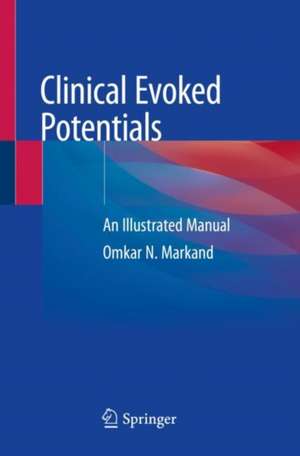Clinical Evoked Potentials: An Illustrated Manual
Autor Omkar N. Markanden Limba Engleză Paperback – 15 feb 2021
Concise and comprehensive, this case-study rich text is divided into five chapters. Beginning with basic principles of evoked potential recording, the first chapter discusses signal enhancement and limitations of signal averaging. Chapter two then provides an overview of brainstem auditory EPs. Subsequent chapters then present visual EPs and somatosensory evoked potentials. Finally, the book concludes with clinical applications of transcranial magnetic stimulation, as well as a brief discussion of the techniques of transcranial electrical motor evoked potentials during intraoperative monitoring.
Clinical Evoked Potentials: An Illustrated Manual functions as an essential reference for neurologists neurosurgeons, anesthesiologists, clinical neurophysiologists, and EP technologists, who are involved with the recording and interpretation of EPs primarily for diagnostic purposes.
| Toate formatele și edițiile | Preț | Express |
|---|---|---|
| Paperback (1) | 588.74 lei 38-44 zile | |
| Springer International Publishing – 15 feb 2021 | 588.74 lei 38-44 zile | |
| Hardback (1) | 839.41 lei 38-44 zile | |
| Springer International Publishing – 15 feb 2020 | 839.41 lei 38-44 zile |
Preț: 588.74 lei
Preț vechi: 619.72 lei
-5% Nou
Puncte Express: 883
Preț estimativ în valută:
112.67€ • 116.91$ • 94.17£
112.67€ • 116.91$ • 94.17£
Carte tipărită la comandă
Livrare economică 12-18 martie
Preluare comenzi: 021 569.72.76
Specificații
ISBN-13: 9783030369576
ISBN-10: 3030369579
Pagini: 242
Ilustrații: XVI, 242 p. 131 illus., 18 illus. in color.
Dimensiuni: 155 x 235 x 20 mm
Greutate: 0.43 kg
Ediția:1st ed. 2020
Editura: Springer International Publishing
Colecția Springer
Locul publicării:Cham, Switzerland
ISBN-10: 3030369579
Pagini: 242
Ilustrații: XVI, 242 p. 131 illus., 18 illus. in color.
Dimensiuni: 155 x 235 x 20 mm
Greutate: 0.43 kg
Ediția:1st ed. 2020
Editura: Springer International Publishing
Colecția Springer
Locul publicării:Cham, Switzerland
Cuprins
1. Basic Techniques Of Evoked Potential Recording.- 2. Brainstem Auditory Evoked Potentials.- 3. Visual Evoked Potentials.- 4. Somatosensory Evoked Potentials.- 5. Motor Evoked Potentials.
Notă biografică
Omkar N. Markand
Department of Neurology
Indiana University School of Medicine
Indianapolis, IN, USA
Department of Neurology
Indiana University School of Medicine
Indianapolis, IN, USA
Textul de pe ultima copertă
This book covers all aspects of evoked potentials (EPs) utilized clinically in evaluating the functional integrity of somatosensory, auditory, motor, and visual pathways in the nervous system. It explores techniques needed to correctly perform EPs, and discusses these clinical neurophysiological tests that are performed in academic institutions and large community hospitals.Concise and comprehensive, this case-study rich text is divided into five chapters. Beginning with basic principles of evoked potential recording, the first chapter discusses signal enhancement and limitations of signal averaging. Chapter two then provides an overview of brainstem auditory EPs. Subsequent chapters then present visual EPs and somatosensory evoked potentials. Finally, the book concludes with clinical applications of transcranial magnetic stimulation, as well as a brief discussion of the techniques of transcranial electrical motor evoked potentials during intraoperative monitoring.Clinical Evoked Potentials: An Illustrated Manual functions as an essential reference for neurologists neurosurgeons, anesthesiologists, clinical neurophysiologists, and EP technologists, who are involved with the recording and interpretation of EPs primarily for diagnostic purposes.
Caracteristici
Describes fully and with numerous illustrations the evoked potential (EP) abnormalities in major neurologic disorders Provides easy to understand the clinical significance of normal and abnormal EPs for practicing neurologists and other referring physicians Provides relevant technical information on performing EPs and how to modify the technique to obtain maximum and clinically relevant information from the procedure Includes actual case studies of the EP abnormalities and describes a concise method of writing appropriate EP reports for the referring physicians
